A Comprehensive Radiological Survey of Groundwater Resources in Artisanal Mining Communities in the Eastern Region of Ghana: Water Quality vs. Mining Activities
Abstract
1. Introduction
2. Materials and Methods
2.1. Study Area
2.2. Sampling
2.3. Radioactivity Measurement
2.4. Radionuclides Activity Concentration
2.5. Statistical Analysis
2.6. Estimation of Health Hazards Due to Ingestion of Ra-226, Ra-228, and K-40 in Groundwater
3. Results
3.1. Activity Concentrations of Ra-226, Ra-228, and K-40 in Groundwater
3.2. Activity Ratios and Characteristics of Groundwater Aquifer
3.3. Groundwater Quality for Drinking Purpose and Dose Estimation
4. Conclusions
Author Contributions
Funding
Data Availability Statement
Conflicts of Interest
References
- Sherif, M.I.; Sturchio, N.C. Radionuclide geochemistry of groundwater in the Eastern Desert, Egypt. Appl. Geochem. 2018, 93, 69–80. [Google Scholar] [CrossRef]
- Fang, S.-C. Study on 14C dating analysis of deep groundwater resources on islands. J. Environ. Radioact. 2019, 208–209, 105994. [Google Scholar] [CrossRef] [PubMed]
- Baeza, A.; Salas, A.; Guillen, J.; Munoz-Serrano, A.; Ontalba-Salamanca, M.A.; Jimenez-Ramos, M.C. Removal of naturally occurring radionuclides from drinking water using a filter specifically designed for Drinking Water Treatment Plants. Chemosphere 2017, 167, 107–113. [Google Scholar] [CrossRef] [PubMed]
- Alomari, A.H.; Saleh, M.A.; Hashima, S.; Alsayaheen, A.; Abdeldin, I.; Abukashabeh, A. 238U and 232Th isotopes in groundwater of Jordan: Geological influence, water chemistry, and health impact. Radiat. Phys. Chem. 2020, 170, 108660. [Google Scholar] [CrossRef]
- Csondor, K.; Bajak, P.; Surbeck, H.; Izsak, B.; Horvath, A.; Vargha, M.; Eross, A. Transient nature of riverbank filtered drinking water supply systems—A new challenge of natural radioactivity assessment. J. Environ. Radioact. 2020, 211, 106072. [Google Scholar] [CrossRef] [PubMed]
- Erőss, A.; Csondor, K.; Izsák, B.; Vargha, M.; Horváth, A.; Pándics, T. Uranium in groundwater- The importance of hydraulic regime and groundwater flow system’s understanding. J. Environ. Radioact. 2018, 195, 90–96. [Google Scholar] [CrossRef] [PubMed]
- Shabana, E.I.; Kinsara, A.A. Radioactivity in the groundwater of a high background radiation area. J. Environ. Radioact. 2014, 137, 181–189. [Google Scholar] [CrossRef]
- Turhan, S.; Özcıtak, E.; Taskın, H.; Varinlioglu, A. Determination of natural radioactivity by gross alpha and beta measurements in ground water samples. Water Res. 2013, 47, 3103–3108. [Google Scholar] [CrossRef]
- Zhong, Q.; Wang, X.; Wang, Q.; Zhang, F.; Li, L.; Wang, Y.; Du, J. 222Rn, 210Pb and 210Po in coastal zone groundwater: Activities, geochemical behaviors, consideration of seawater intrusion effect, and the potential radiation human-health risk. Appl. Radiat. Isot. 2020, 166, 109386. [Google Scholar] [CrossRef]
- Örgün, Y.; Altınsoy, N.; Gültekin, A.H.; Karahan, G.; Celebi, N. Natural radioactivity levels in granitic plutons and groundwaters in Southeast part of Eskisehir, Turkey. Appl. Radiat. Isot. 2005, 63, 267–275. [Google Scholar] [CrossRef]
- Mathuthu, M.; Uushona, V.; Indongo, V. Radiological safety of groundwater around a uranium mine in Namibia. Phys. Chem. Eart. 2021, 122, 102915. [Google Scholar] [CrossRef]
- Akweetelela, A.; Kgabi, N.; Zivuku, M.; Mashauri, D. Environmental radioactivity of groundwater and sediments in the Kuiseb and Okavango-Omatako basins in Namibia. Phys. Chem. Eart. 2020, 120, 102911. [Google Scholar] [CrossRef]
- UNSCEAR. Sources and Effects of Ionizing Radiation: Sources; United Nations Publications: New York, NY, USA, 2000; Volume 1. [Google Scholar]
- Selvi, B.; Vijayakumar, B.; Rana, B.; Ravi, P. Distribution of natural uranium in groundwater around Kudankulam. Radiat. Prot. Environ. 2016, 39, 15–25. [Google Scholar] [CrossRef]
- Gordon, C.; Nukpezah, D.; Tweneboah-Lawson, E.; Ofori, B.D.; Yirenya-Tawiah, D.; Pabi, O.; Ayivor, J.S.; Koranteng, S.; Darko, D.; Mensah, A.M. West Africa—Water resources vulnerability using a multidimensional approach: Case study of Volta Basin. In Climate Vulnerability: Understanding and Addressing Threats to Essential Resources; Elsevier Inc.: Amsterdam, The Netherlands, 2013; pp. 283–309. [Google Scholar]
- Gampson, E.K.; Nartey, V.K.; Golow, A.A.; Akiti, T.T.; Sarfo, M.A.; Salifu, M.; Aidoo, F.; Fuseini, A.R. Physical and isotopic characteristics in peri-urban landscapes: A case study at the lower Volta River Basin, Ghana. Appl. Water Sci. 2017, 7, 729–744. [Google Scholar] [CrossRef]
- Yidana, S.M.; Banoeng-Yakubo, B.; Aliou, A.-S.; Akabzaa, T.M. Groundwater quality in some Voltaian and Birimian aquifers in northern Ghana- application of mulitvariate statistical methods and geographic information systems. Hydrol. Sci. 2012, 57, 1168–1183. [Google Scholar] [CrossRef]
- Bansah, K.J.; Dumakor-Dupey, N.K.; Kansake, B.A.; Assan, E.; Bekui, P. Socioeconomic and environmental assessment of informal artisanal and small-scale mining in Ghana. J. Cleaner Prod. 2018, 202, 465–475. [Google Scholar] [CrossRef]
- Snapir, B.; Simms, D.M.; Waine, T.W. Mapping the expansion of galamsey gold mines in the cocoa growing area of Ghana using optical remote sensing. Intl. J. Appl. Eart Obser. Geoinf. 2017, 58, 225–233. [Google Scholar] [CrossRef]
- Yankson, P.W.K.; Gough, K.V. Gold in Ghana: The effects of changes in large-scale mining on artisanal and small-scale mining (ASM). Extrac. Indust. Soc. 2019, 6, 120–128. [Google Scholar] [CrossRef]
- Patel, K.; Rogan, J.; Cuba, N.; Bebbington, A. Evaluating conflict surrounding mineral extraction in Ghana: Assessing the spatial interactions of large and small-scale mining. Extrac. Indust. Soc. 2016, 3, 450–463. [Google Scholar] [CrossRef]
- Klubi, E.; Abril, J.M.; Mantero, J.; García-Tenorio, R.; Nyarko, E. Environmental radioactivity and trace metals in surficial sediments from estuarine systems in Ghana (Equatorial Africa), impacted by artisanal gold-mining. J. Environ. Radioact. 2020, 218, 106260. [Google Scholar] [CrossRef]
- Giri, S.; Singh, G.; Jha, V.N. Evaluation of radionuclides in groundwater around proposed uranium mining sites in Bagjata and Banduhurang, Jharkhand (India). Radiationprotection 2011, 46, 39–57. [Google Scholar] [CrossRef][Green Version]
- MOFEP. Programme-Based Budget Estimates for 2019, Atiwa West District Assembly. Ministry of Finance, Composite Budget for 2019–2022. Available online: https://mofep.gov.gh/sites/default/files/composite-budget/2019/ER/Atiwa-West.pdf (accessed on 23 July 2023).
- Amponsah, A.; Nasare, L.I.; Tom-Dery, D.; Baatuuwie, B.N. Land cover changes of Atiwa Range Forest Reserve, a biodiversity hotspot in Ghana. Trees For. People 2022, 9, 100301. [Google Scholar] [CrossRef]
- GSS. Ghana Statistical Service (GSS) 2010 Population & Housing Census, District Analytical Report, Atiwa District, October 2014. Available online: https://www2.statsghana.gov.gh/docfiles/2010_District_Report/Eastern/ATIWA.pdf (accessed on 23 July 2023).
- NDPC. National Development Planning Commission (NDPC) 2019 Annual Progress Report on the Implementation of the District Medium Term Development Plan 2018–2021 of The Agenda for Jobs: Creating Prosperity and Equal Opportunity for All, 2018–2021, Atiwa West District Assembly, January 2020. Available online: https://ndpc.gov.gh/media/ER_Atiwa_West_APR_2019.pdf (accessed on 23 July 2023).
- Akuo-ko, E.O.; Adelikhah, M.; Amponsem, E.; Csordas, A.; Kovacs, T. Radiological assessment in beach sediment of coastline, Ghana. Heliyon 2023, 9, E16690. [Google Scholar] [CrossRef] [PubMed]
- WHO. Guidelines for Drinking Water Quality, 4th ed.; World Health Organization: Genewa, Switzerland, 2011; pp. 1–541. [Google Scholar]
- ICRP. Protection from potential exposures—Application to selected radiation sources. Ann. ICRP 1997, 27, 76. [Google Scholar]
- WHO. Guidelines for Drinking-Water Quality, 3rd ed.; World Health Organizatiom: Genewa, Switzerland, 2008; Volume 1. [Google Scholar]
- Avwiri, G.O.; Osimobi, J.C.; Agbalagba, E.O. Evaluation of natural occurring radionuclide variation with lithology depth profile of Udi and Ezeagu local government areas of Enugu State, Nigeria. Int. J. Engin. Appl. Sci. 2013, 4, 1–10. [Google Scholar]
- Ravisankar, R.; Chandramohan, J.; Chandrasekaran, A.; Jebakumar, J.P.P.; Vijayalakshmi, I.; Vijayagopal, P.; Venkatraman, B. Assessments of radioactivity concentration of natural radionuclides and radiological hazard indices in sediment samples from the East coast of Tamilnadu, India with statistical approach. Mar. Pollut. Bull. 2015, 97, 419–430. [Google Scholar] [CrossRef] [PubMed]
- Yehia, M.; Baghdady, A.; Howari, F.M.; Awad, S.; Gad, A. Natural radioactivity and groundwater quality assessment in the northern area of the Western Desert of Egypt. J. Hydrol. Reg. Stud. 2017, 12, 331–344. [Google Scholar] [CrossRef]
- Hakam, O.K.; Choukri, A.; Reyss, J.L.; Lferde, M. Determination and comparison of uranium and radium isotopes activities and activity ratios in samples from some natural water sources in Morocco. J. Environ. Radioact. 2001, 57, 175–189. [Google Scholar] [CrossRef] [PubMed]
- Kiro, Y.; Weinstein, Y.; Starinsky, A.; Yechieli, Y. Application of radon and radium isotopes to groundwater flow dynamics: An example from the Dead Sea. Chem. Geol. 2015, 411, 155–171. [Google Scholar] [CrossRef]
- Gumma, M.K.; Pavelic, P. Mapping of groundwater potential zones across Ghana using remote sensing, geographic information systems, and spatial modeling. Environ. Monit. Assess. 2012, 185, 3561–3579. [Google Scholar] [CrossRef]
- Bello, S.; Nasiru, R.; Garba, N.N.; Adeyemo, D.J. Evaluation of the activity concentration of 40K, 226Ra and 232Th in soil and associated radiological parameters of Shanono and Bagwai artisanal gold mining areas, Kano State, Nigeria. J. Appl. Sci. Environ. Manag. 2019, 23, 1655–1659. [Google Scholar] [CrossRef]
- Attiogbe, F.K.; Mohammed, A.R.; Kingslove, Q. Assessing the potential health impact of selected heavy metals that pollute Lake Amponsah in Bibiani, Western North region, Ghana. Scient. Afr. 2020, 9, e00531. [Google Scholar] [CrossRef]
- Faanu, A.; Adukpo, O.K.; Kansaana, C.; Tettey-Larbi, L.; Lawluvi, H.; Kpeglo, D.O.; Darko, E.O.; Emi-reynolds, G.; Awudu, R.A.; Amoah, P.A.; et al. Impact assessment of naturally occurring radioactive materials on the public from gold mining and processing at Newmont Golden Ridge Limited, Akyem, Eastern region of Ghana. Radiat. Prot. Environ. 2016, 39, 155–164. [Google Scholar] [CrossRef]
- Olise, F.; Akinnagbe, D.M.; Olasogba, O.S. Radionuclides and radon levels in soil and groundwater from solid minerals-hosted area, South- Western Nigeria. Cog. Environ. Sci. 2016, 2, 1142344. [Google Scholar] [CrossRef]
- Galhardi, J.A.; García-Tenorio, R.; Bonotto, D.M.; Frances, I.D.; Motta, J.G. Natural radionuclides in plants, soils and sediments affected by U-rich coal mining activities in Brazil. J. Environ. Radioact. 2017, 177, 37–47. [Google Scholar] [CrossRef] [PubMed]
- Alazemi, N.; Bajoga, A.D.; Bradley, D.A.; Regan, P.H.; Shams, H. Soil radioactivity levels, radiological maps and risk assessment for the state of Kuwait. Chemosphere 2016, 154, 55–62. [Google Scholar] [CrossRef] [PubMed]
- Raghavendran, S.; Deka, P.C. Sustainable development and management of groundwater resources in mining affected areas: A review. Procedia Eart. Planet. Sci. 2015, 11, 598–604. [Google Scholar] [CrossRef]
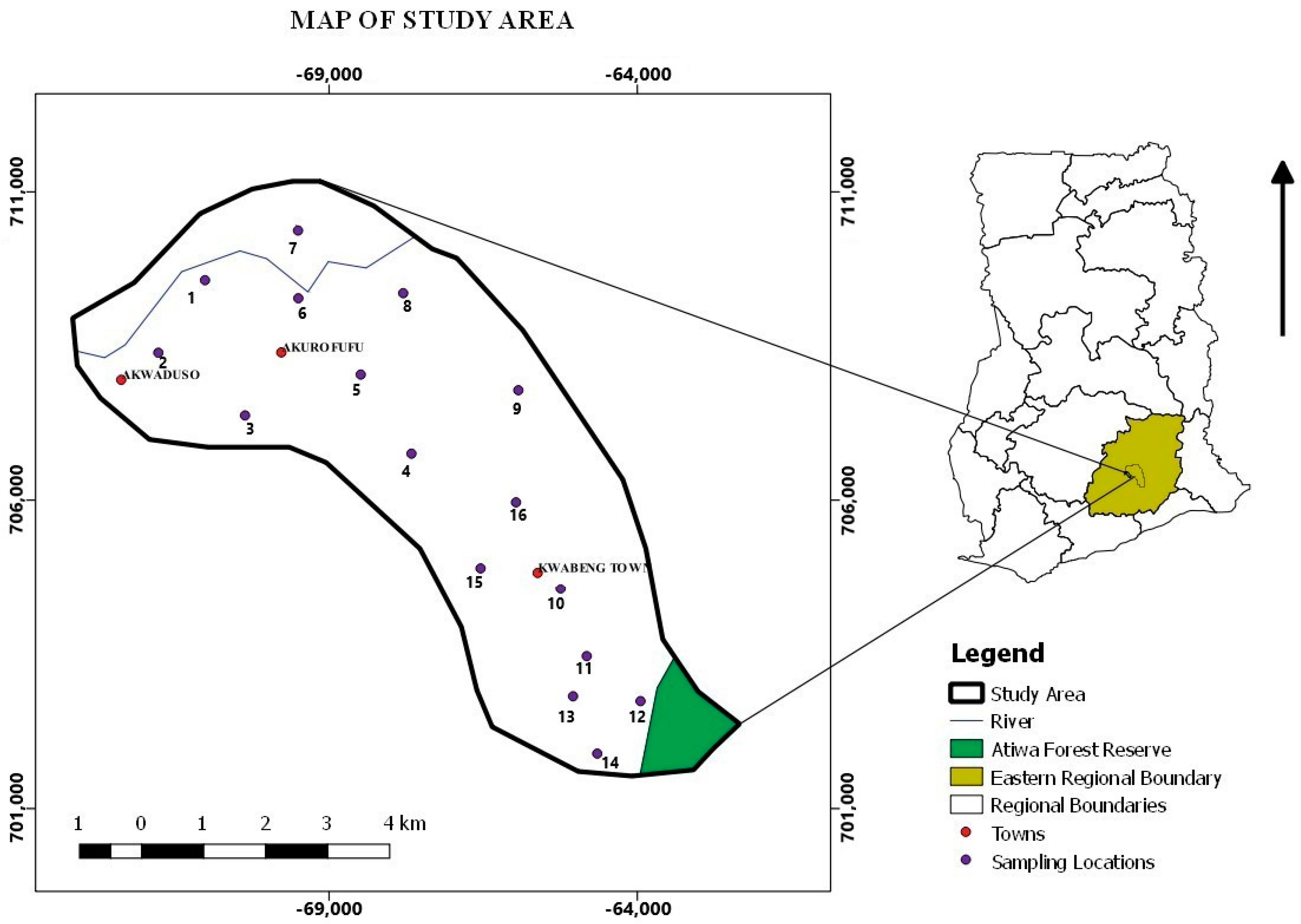
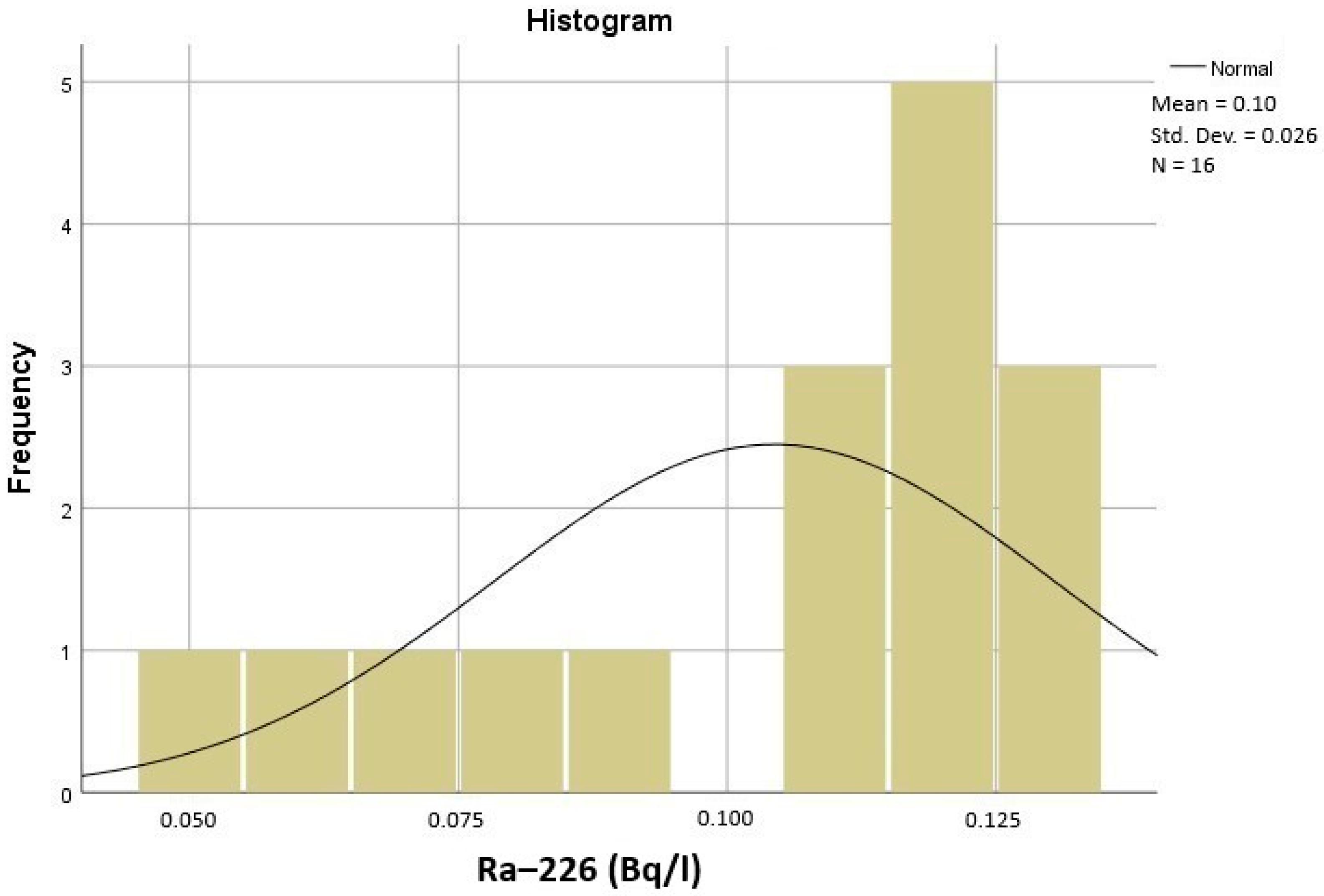
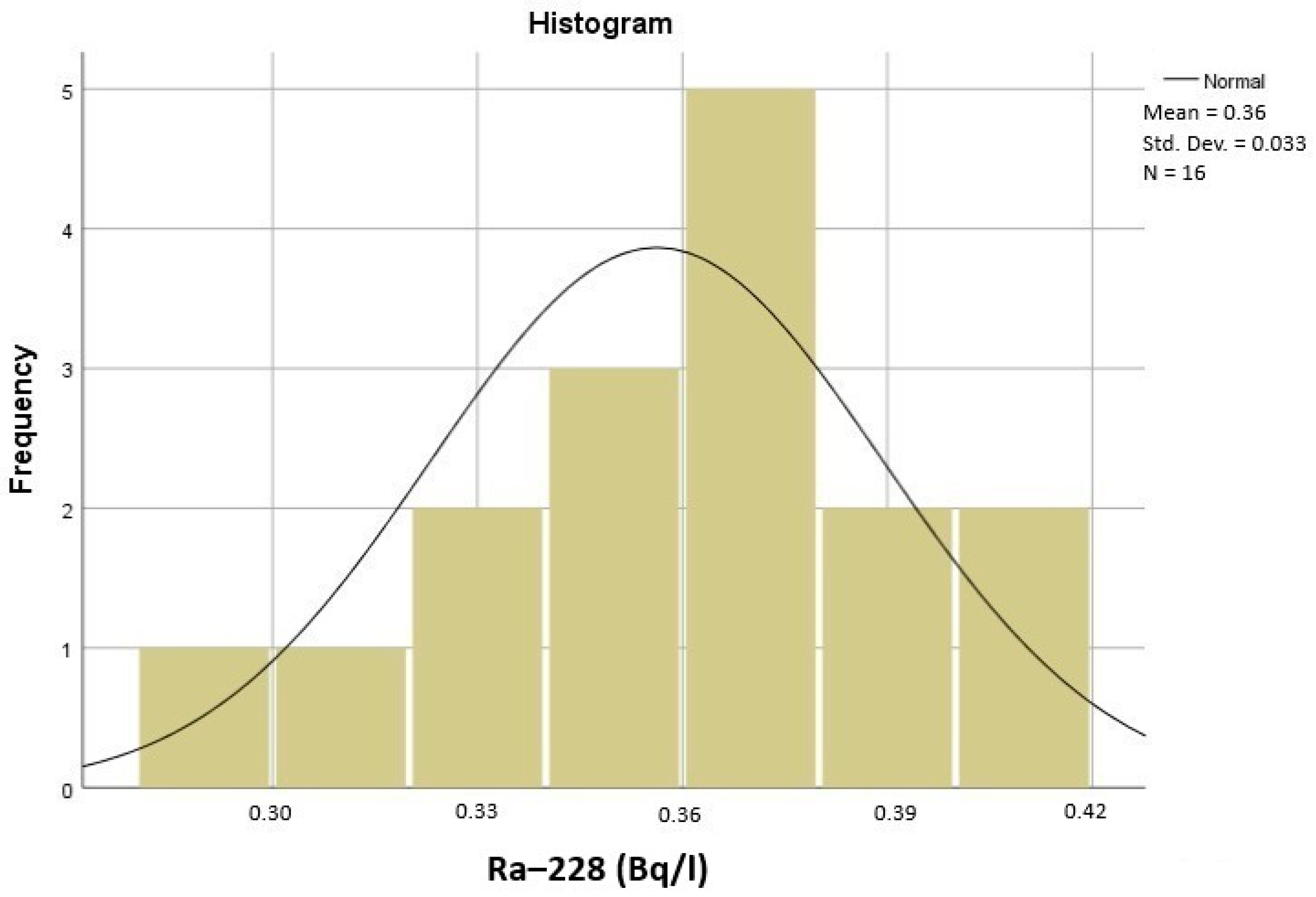
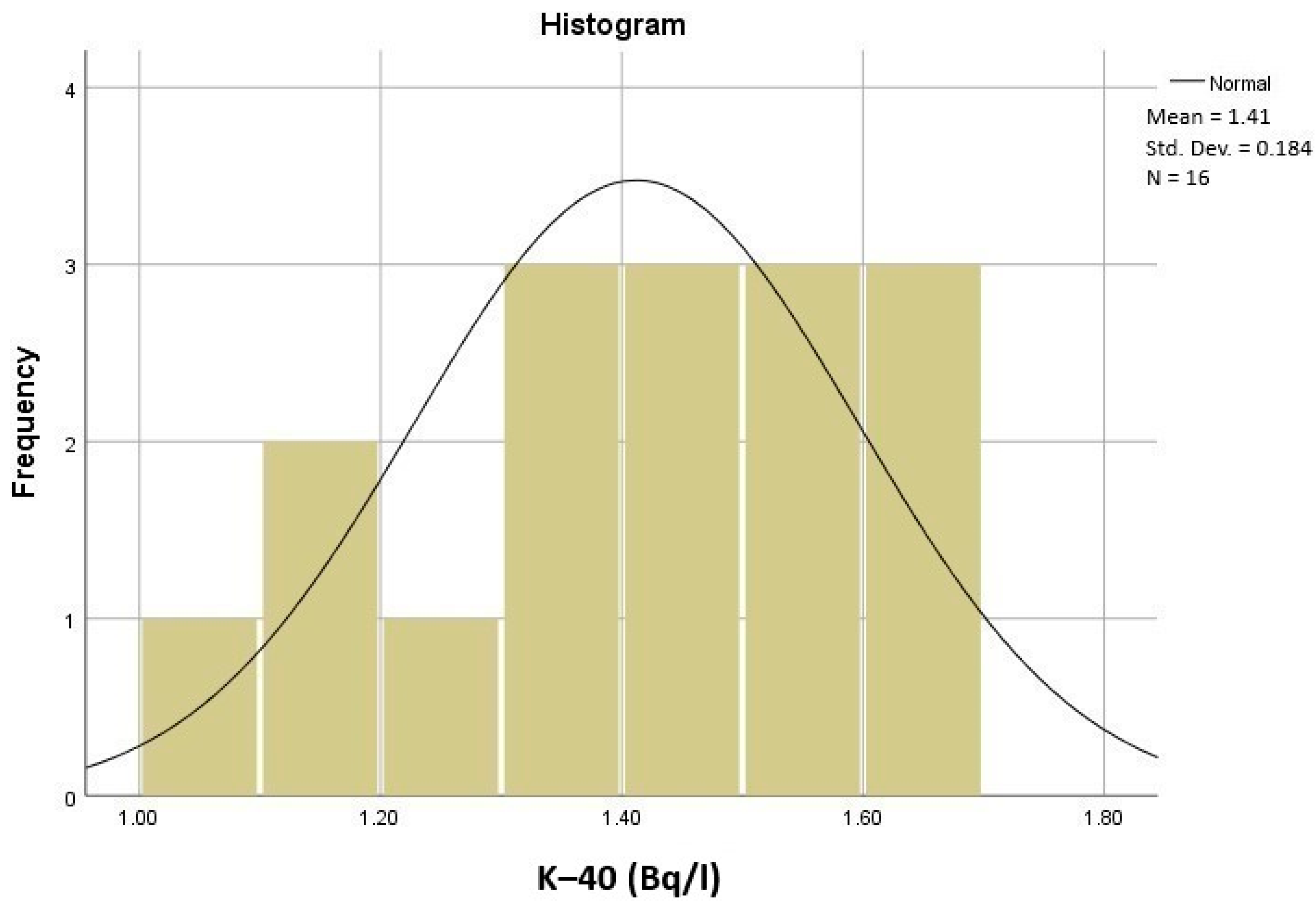

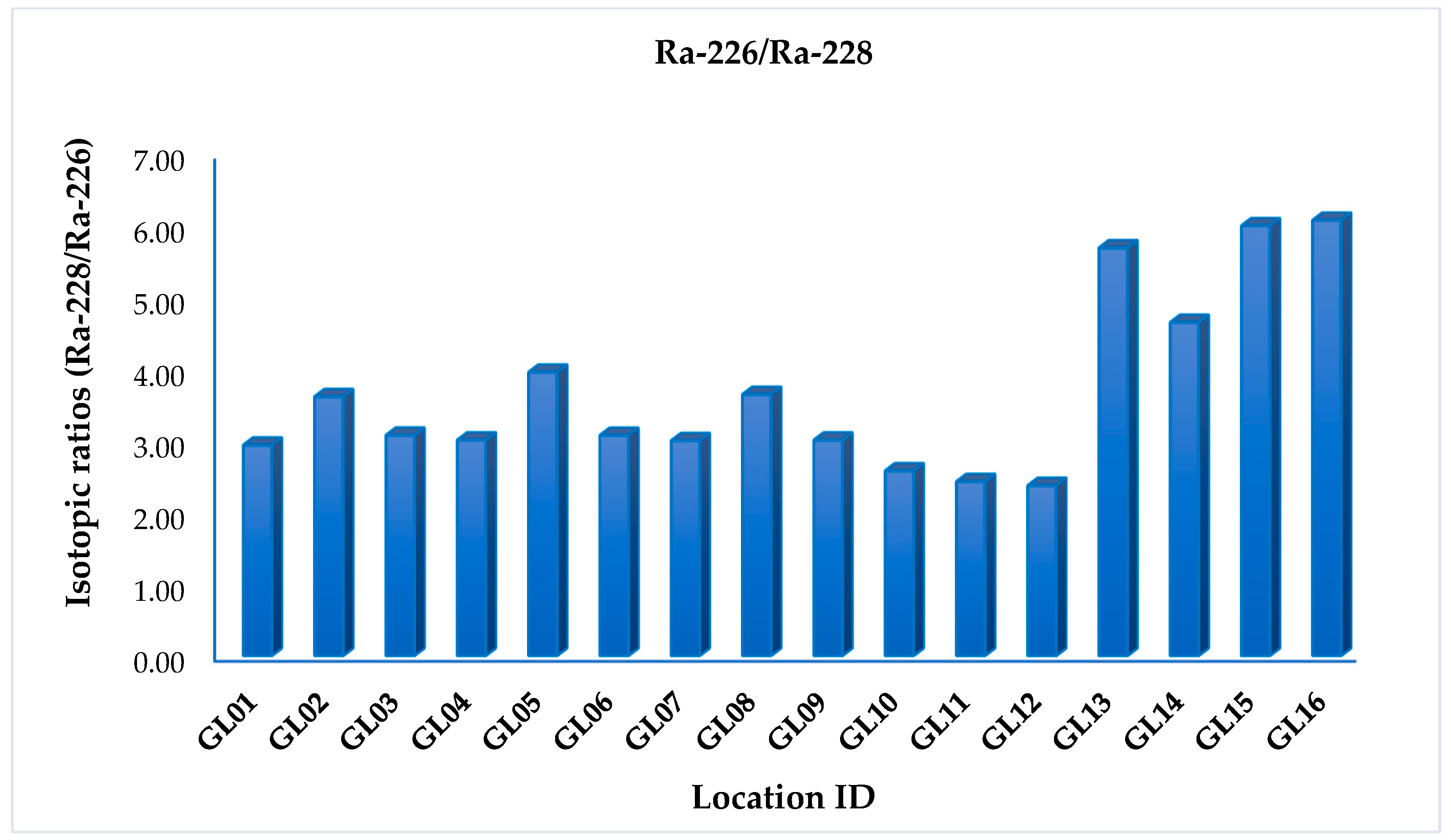

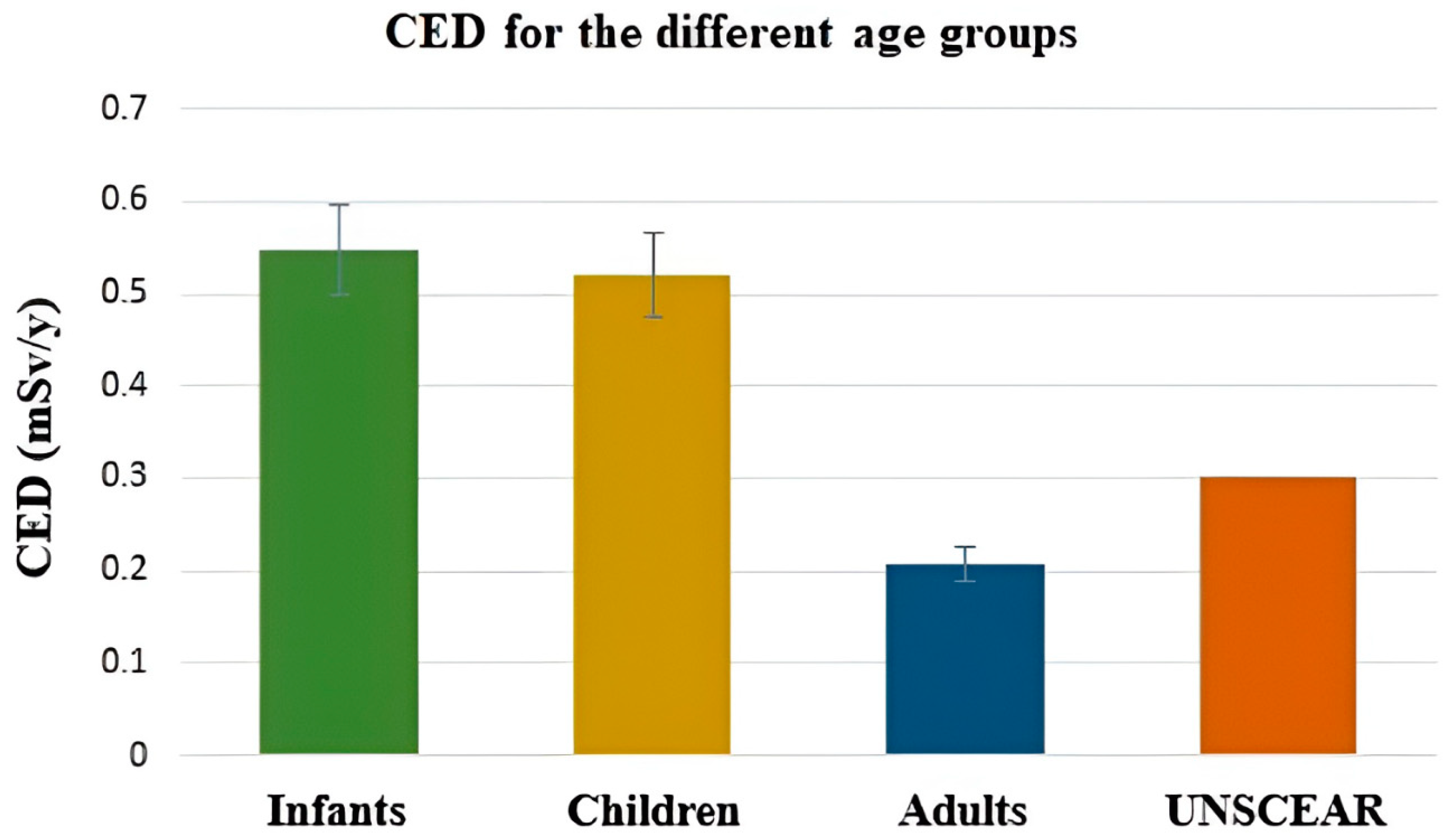
| Ra-226 (Bq/L) | Ra-228 (Bq/L) | K-40 (Bq/L) | |
|---|---|---|---|
| Average | 0.10 | 0.36 | 1.41 |
| Minimum | 0.05 | 0.29 | 1.09 |
| Maximum | 0.13 | 0.41 | 1.65 |
| Median | 0.12 | 0.36 | 1.41 |
| Standard deviation | 0.03 | 0.03 | 0.18 |
| Kurtosis | −0.26 | −0.37 | −0.89 |
| Skewness | −1.02 | −0.34 | −0.43 |
| Geometric mean | 0.10 | 0.35 | 1.40 |
Disclaimer/Publisher’s Note: The statements, opinions and data contained in all publications are solely those of the individual author(s) and contributor(s) and not of MDPI and/or the editor(s). MDPI and/or the editor(s) disclaim responsibility for any injury to people or property resulting from any ideas, methods, instructions or products referred to in the content. |
© 2023 by the authors. Licensee MDPI, Basel, Switzerland. This article is an open access article distributed under the terms and conditions of the Creative Commons Attribution (CC BY) license (https://creativecommons.org/licenses/by/4.0/).
Share and Cite
Akuo-ko, E.O.; Otoo, F.; Glover, E.T.; Amponsem, E.; Tettey-Larbi, L.; Csordás, A.; Kovács, T.; Shahrokhi, A. A Comprehensive Radiological Survey of Groundwater Resources in Artisanal Mining Communities in the Eastern Region of Ghana: Water Quality vs. Mining Activities. Water 2024, 16, 62. https://doi.org/10.3390/w16010062
Akuo-ko EO, Otoo F, Glover ET, Amponsem E, Tettey-Larbi L, Csordás A, Kovács T, Shahrokhi A. A Comprehensive Radiological Survey of Groundwater Resources in Artisanal Mining Communities in the Eastern Region of Ghana: Water Quality vs. Mining Activities. Water. 2024; 16(1):62. https://doi.org/10.3390/w16010062
Chicago/Turabian StyleAkuo-ko, Esther Osei, Francis Otoo, Eric Tetteh Glover, Eunice Amponsem, Lordford Tettey-Larbi, Anita Csordás, Tibor Kovács, and Amin Shahrokhi. 2024. "A Comprehensive Radiological Survey of Groundwater Resources in Artisanal Mining Communities in the Eastern Region of Ghana: Water Quality vs. Mining Activities" Water 16, no. 1: 62. https://doi.org/10.3390/w16010062
APA StyleAkuo-ko, E. O., Otoo, F., Glover, E. T., Amponsem, E., Tettey-Larbi, L., Csordás, A., Kovács, T., & Shahrokhi, A. (2024). A Comprehensive Radiological Survey of Groundwater Resources in Artisanal Mining Communities in the Eastern Region of Ghana: Water Quality vs. Mining Activities. Water, 16(1), 62. https://doi.org/10.3390/w16010062








